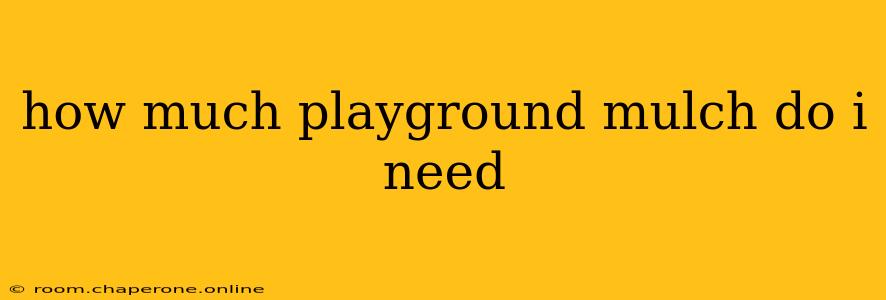Determining the precise amount of playground mulch needed for your project can seem daunting, but with the right approach, it becomes straightforward. This comprehensive guide walks you through the process, ensuring you get the perfect amount without overspending or falling short. We'll cover everything from accurate measurements to understanding depth requirements and factoring in potential waste.
Understanding Playground Mulch Depth Requirements
The most crucial factor influencing the amount of mulch you need is the depth. Safety regulations typically dictate a minimum depth, often ranging from 6 to 12 inches. Always check your local regulations and guidelines, as these can vary significantly. A deeper layer offers better impact absorption and protection for children.
Consider these factors when determining the appropriate depth:
- Age of children: Younger children require a thicker layer of mulch for better protection during falls.
- Type of surface: A sloped surface may require slightly more mulch to maintain the required depth.
- Substrate: If you're placing the mulch over a hard surface, you might need a slightly deeper layer compared to a more yielding base.
Calculating the Area: Beyond Simple Length x Width
Accurately calculating the area of your playground is vital. While simple length x width works for rectangular areas, most playgrounds have irregular shapes. Here's a breakdown of methods:
1. Rectangular or Square Playgrounds:
This is the simplest calculation:
- Measure the length and width of the playground area in feet.
- Multiply the length by the width: This gives you the square footage. For example, a 10ft x 15ft area is 150 sq ft.
2. Irregularly Shaped Playgrounds:
For more complex shapes, break the area into smaller, manageable sections (rectangles, squares, triangles). Calculate the area of each section individually and add them together. If you have highly irregular shapes, consider using online area calculators or consulting a professional.
3. Accounting for Obstacles:
Remember to subtract the area covered by permanent structures like play equipment, benches, or other fixed elements. Measure the area occupied by each obstacle and deduct it from the total calculated area.
Converting Square Footage to Cubic Yards
Mulch is typically sold in cubic yards. To convert your square footage to cubic yards, you'll need to consider the depth:
- Convert depth to feet: Divide the depth in inches by 12. For example, a 9-inch depth equals 0.75 feet.
- Calculate the volume in cubic feet: Multiply the square footage by the depth in feet. Using our 150 sq ft example with a 9-inch depth: 150 sq ft x 0.75 ft = 112.5 cubic feet.
- Convert cubic feet to cubic yards: Divide the cubic footage by 27 (since there are 27 cubic feet in a cubic yard). 112.5 cubic feet / 27 cubic feet/cubic yard = 4.17 cubic yards.
Adding a Safety Margin: Waste and Compaction
It's crucial to account for waste and compaction. Mulch settles over time, so adding 10-15% extra to your calculated amount is a good safety measure. In our example, adding 15% to 4.17 cubic yards gives you approximately 4.8 cubic yards.
Ordering Your Playground Mulch
Always round up to the nearest whole cubic yard when ordering to avoid running short. Consider contacting your supplier to discuss your needs; they often have experience and can assist with accurate estimations.
Conclusion
Calculating the amount of playground mulch needed is a process that requires careful measurement and consideration of depth requirements, area calculations, and potential waste. By following these steps, you'll ensure your playground has the right amount of mulch for safety and enjoyment for years to come. Remember to always prioritize safety and check your local regulations for specific depth recommendations.

